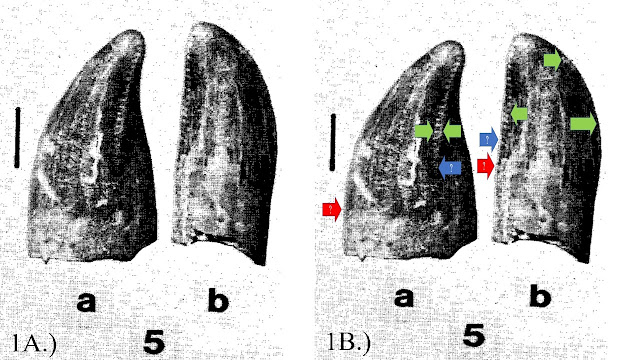Written on 1/17/23.
Link:
https://www.academia.edu/96575022/A_Baby_Tyrannosaurus_rex_Premaxillary_or_First_Maxillary_Tooth
A Baby Tyrannosaurus rex Premaxillary, or First Maxillary, Tooth
Abstract
In Dr. Kenneth Carpenter’s 1982 paper describing baby dinosaur dentaries and teeth, one tooth cataloged as UCMP 119853 seemed to have a morphology reminiscent of adult
Tyrannosaurus rex specimens. After an extensive critique of the tooth, along with comments
from other professional paleontologists (Professor Holtz, Jr., Sebastian Dalman, and Dr. Joshua
B. Smith), this author believes that UCMP 119853 is a baby T. rex tooth that was situated in
either the premaxillary (first or second), or the first maxillary, position. This author tends to lean
more towards the premaxillary, but is still open to the possibility that the specimen is a first
maxillary tooth. UCMP 119853 has a single carina that overlaps the tip of the tooth and is
located in the labial and lingual positions of the crown, and the carina is denticulate. The
morphology of UCMP 119853 differs from that of other young tyrannosauroid specimens that
are categorized as either “Nanotyrannus,” or “juvenile T. rex specimens” (which this author
categorizes as cf. Dryptosaurus aquilinguis). A comparison between UCMP 119853 and the
premaxillary, and first maxillary, teeth from other tyrannosauroid genera showed that T. rex’s
tooth morphology stayed consistent throughout the animal’s lifetime, and was close to that of the
genus’ sister taxon Tyrannosaurus/Tarbosaurus bataar.
Figures:
Figure 1: UCMP 119853. 1A.) The fossil as shown in Carpenter (1982). 5a is the lateral, and 5b
is the posterior/lingual/distal view. 1B.) Arrows indicating the location, and endpoints, of the
carina. Green arrows indicate the carina is located on the lateral (labial and lingual) sides of the
tooth. The blue arrows indicate to the author where the carina ended. The red arrows indicate
where the carine ended according to Dr. Smith:
Table 1: T. rex and cf. Dryptosaurus aquilinguis premaxillary tooth lengths and morphologies. The results indicated that the morphologies of the teeth in the two genera stayed consistent, aside from an increase in size during maturity. “(C)” means crown height measurement, and “(T)” means total tooth height measurement. Note: This author obtained a length of 3 cm for YPM 296, but Ford and Chure (2001) gave 2.9 cm (Table 1). This was discovered after the author already measured the specimen:Table 2: Tyrannosauroid premaxillary tooth morphologies. The results showed that the morphology of the cf. Dryptosaurus aquilinguis premaxillary teeth were closer to the other basal tyrannosauroids than to T. rex’s. T. rex’s premaxillary tooth morphology was closer to T. bataar’s than the other taxa listed:






.png)







.jpg)

